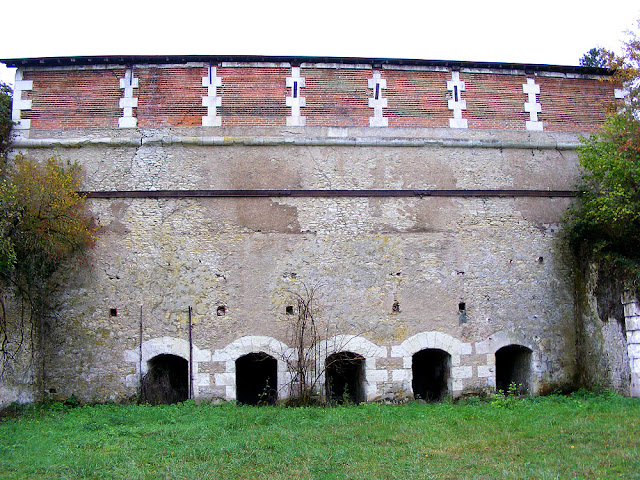Limestone and clay abounds in the Loire Valley, so there were once lime, brick and tile kilns all over. Around Loches there were once 83 kilns (29 for lime and 54 for bricks). Of this industrial abundance, 32 kilns have been preserved as historical artefacts. Lime kiln in French is four à chaux.
 |
| The impressive north front of the lime kiln, with the extraction bays at the bottom. |
The battery of three lime kilns built in 1872 at Marsin, near Chemillé-sur-Indrois, is one of the most impressive. Their capacity is about 80 cubic metres.
 |
| Inside the base of the kiln. |
The five hectare privately owned Marsin complex includes the boilermakers house, which was added in 1875. It is now restored and occupied. The kilns, which probably ceased operation in 1914, are now filled with all sorts of stuff. The complex was owned by the Raoul Duval-Dassier family, mining engineers and farmers, who had earlier established a tile factory in Genillé, and lived at the Chateau de Marolles. Maurice Raoul-Duval, who inherited Marolles, was killed at Verdun in 1916.
 |
| Inside the kiln. |
From 1881 to 1914 there was only one fulltime employee, who was the boilermaker. Other workers were seconded from the nearby Chateau de Marolles staff as and when needed.
The kilns ran continuously, producing lime for use in agriculture. The raw material was extracted from a limestone cliff about 40 metres to the south. The kilns are built into the cliff too and are about 20 metres wide, with a drop of 18 metres. They are loaded from the top on the southern side into hoppers, and unloaded from the five bays at the front, on the north of the site.
We are also on Instagram, so check us out to see a regularly updated selection of our very best photos.

4 comments:
Living in a great limestone area they are all over the place here. Nothing as large as that one though.
Yes, this one is rather mahoosive -- but there were even bigger ones not that far away. It's right on the side of the road too, although admittedly not a road anyone drives down much.
There is a house called the four à chaux just along the old disused railway line from Le Grand-Pressigny in the direction of Paulmy. We often hung our noses over it when it seemed to be empty and unlived in. As it turns out the old lady who used to live there was in a home and now I guess the family use it in the summer.
It's almost a little hamlet in itself but I have seen no evidence of a lime kiln nearby. Next time we do that walk with Hugo I shall take more notice and become more nosey!
I've been taken to a lime kiln in that direction, but it's not close to a house. It's a smallish (as these things go) bottle kiln in the middle of a field. Nothing to see except a mound unless you know to go closer and peer in.
Post a Comment